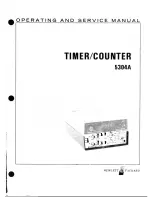
AUBER INSTRUMENTS
WWW.AUBERINS.COM
2015.04 P1/4
JSL-71A Easy Timer with Dual Settings
Version 1.2 (Apr, 2015)
1.
Overview
This JSL-71 timer can count from 0.01 second to 9999 minutes. Operating
function modes include single delay, double delay, and cycle delay. It can
count-down or count-up. The timer can be activated automatically when
powering up, by front key pad, or via remote switch. Two different time delay
settings can be programmed. User can switch the setting with a single key
press. Lock function can be activated to prevent any accidental change.
2. Specification
Timer range: 0.01 second to 9999 minutes
Timer mode: single delay, double delay, cycle delay
Timer trigger: power on, front key pad, or remote switch
Timer accuracy: <1s/day.
Power supply: 90-260V AC or DC.
Power consumption: <2W
Relay output:7A@240VAC,10@120VAC and 24VDC
Relay life: 100,000 times.
Operating temperature: 0-60 ° C.
Humidity: 0-95%RH
Panel cutout: 44.5x44.5mm
Outer dimension: 48x48x85 mm.
3.
Front
Panel
1
3
2
4
5
6
7
8
9
10
Figure1. Front panel
1. RUN indicator: (the red dot at the lower right corner).Turns on when timer
starts running. Turns off when timer stops.
2. Time unit indicator: turns on when time units are M:S or H:M. Turns off when
time unit is M or S.
3. Time range indicator: turns on when the time base is H:M (Hours: Minutes)
or M(Minutes). Turns off when the time base is M:S (Minutes : Seconds) or
S(Seconds).
4. Timer indicators: T1 for first delay time, T2 for second delay time.
5. OUT indicator: Turns on when relay is on. Turns off when relay is off.
6. SET key. When timer is not running, press it will switch between first delay
time setting (T1) and second delay time setting (T2); press and hold it for 3
second will enter the programming mode.
7. Down key / STP key: Lower the time setting value or stop the timer (for
special stop function please see note2 on page 5/5 for details). In the
programming mode, press it will go to the next programming value.
8. Up key / PAU key: When timer is not running, press it will increase the time
setting value. When timer is running, press and hold it will pause the timer. The
timer will continue running after this key is released. In the programming mode,
press it will go to the previous programming value.
9. RST key: Reset key. When timer is running, press it will restart the timer. If
"RUN" parameter is set to RST, press it will start the timer after powered up.
10. LED digital display. During normal operation as a timer, the top displays the
actual time; the bottom displays the set value. In programming mode, the top
displays setting parameters; the bottom displays programming value.
4. Terminal Assignment
5
4
3
2
1
10
9
8
7
6
O
UT
NC
NO
AC
90
~2
60
V
C
OM
ST
P
PAU
R
ST
Figure 2. Terminal assignment.
Details
:
Power for the timer needs to be connected to between terminal 9 and 10. The
voltage should be in the 90 to 260V range.
Terminal 6, 7 and 8 are for relay output. Terminal 6 is Normally-closed (NC)
contact. Terminal 8 is Normally-open (NO) contact. Terminal 7 is common
contact of the terminal 6 and 8. When the relay is energized (or when the OUT
LED is on), terminal 8 connects to terminal 7, and terminal 7 disconnects
terminal 6; When the relay is NOT energized (or when the OUT LED is off),
terminal 6 connects to terminal 7, and terminal 7 disconnects terminal 8. The
relay is a “dry switch” that does not provide power by itself. Please see the
wiring example below.
Terminal 5 is the reset terminal that has the same function as the RST key in
the front panel. Terminal 4 is the pause/mute terminal that function the same
as the “^/PAU” key in the front panel. Terminal 3 is the stop terminal that
function the same as the “V/STP” key in the front panel. Terminal 1 and 2 are
the common contacts of the terminal 3/4/5. There are two ways to operate
terminal 3, 4 and 5.
1) Connecting a normally open (NO) momentary push button switch between
the terminal (3, 4 or 5) to the COM (1 or 2). Please note, the function starts
when you release (or open) the button of the switch, not when you press down
the switch.
Instruction Manual
























